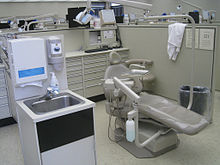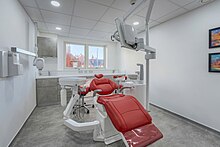
A fire engine or fire truck is a vehicle, usually a specially-designed or modified truck, that functions as a firefighting apparatus. The primary purposes of a fire engine include transporting firefighters and water to an incident as well as carrying equipment for firefighting operations in a fire drill. Some fire engines have specialized functions, such as wildfire suppression and aircraft rescue and firefighting, and may also carry equipment for technical rescue.
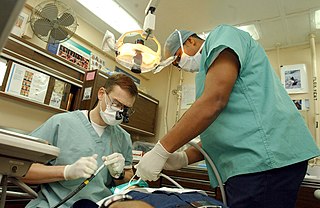
A dentist, also known as a dental surgeon, is a health care professional who specializes in dentistry, the branch of medicine focused on the teeth, gums, and mouth. The dentist's supporting team aids in providing oral health services. The dental team includes dental assistants, dental hygienists, dental technicians, and sometimes dental therapists.
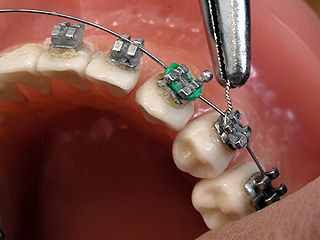
Orthodontics is a dentistry specialty that addresses the diagnosis, prevention, management, and correction of mal-positioned teeth and jaws, as well as misaligned bite patterns. It may also address the modification of facial growth, known as dentofacial orthopedics.

An operating theater is a facility within a hospital where surgical operations are carried out in an aseptic environment.

Dental braces are devices used in orthodontics that align and straighten teeth and help position them with regard to a person's bite, while also aiming to improve dental health. They are often used to correct underbites, as well as malocclusions, overbites, open bites, gaps, deep bites, cross bites, crooked teeth, and various other flaws of the teeth and jaw. Braces can be either cosmetic or structural. Dental braces are often used in conjunction with other orthodontic appliances to help widen the palate or jaws and to otherwise assist in shaping the teeth and jaws.

A dental technician is a member of the dental team who, upon prescription from a dental clinician, constructs custom-made restorative and dental appliances.
Tooth whitening or tooth bleaching is the process of lightening the color of human teeth. Whitening is often desirable when teeth become yellowed over time for a number of reasons, and can be achieved by changing the intrinsic or extrinsic color of the tooth enamel. The chemical degradation of the chromogens within or on the tooth is termed as bleaching.

A dental drill or dental handpiece is a hand-held, mechanical instrument used to perform a variety of common dental procedures, including removing decay, polishing fillings, performing cosmetic dentistry, and altering prostheses. The handpiece itself consists of internal mechanical components that initiate a rotational force and provide power to the cutting instrument, usually a dental burr. The type of apparatus used clinically will vary depending on the required function dictated by the dental procedure. It is common for a light source and cooling water-spray system to also be incorporated into certain handpieces; this improves visibility, accuracy, and the overall success of the procedure. The burrs are usually made of tungsten carbide or diamond.
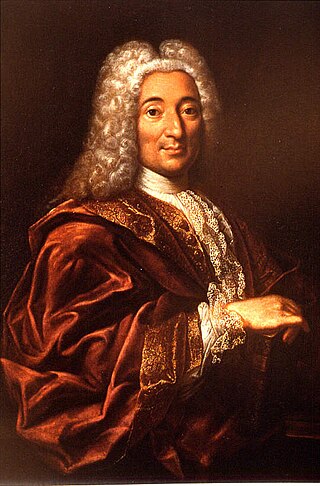
Pierre Fauchard was a French physician, credited as being the "father of modern dentistry". He is widely known for writing the first complete scientific description of dentistry, Le Chirurgien Dentiste, published in 1728. The book described basic oral anatomy and function, signs and symptoms of oral pathology, operative methods for removing decay and restoring teeth, periodontal disease (pyorrhea), orthodontics, replacement of missing teeth, and tooth transplantation.
A dental emergency is an issue involving the teeth and supporting tissues that are of high importance to be treated by the relevant professional. Dental emergencies do not always involve pain, although this is a common signal that something needs to be looked at. Pain can originate from the tooth, surrounding tissues or can have the sensation of originating in the teeth but be caused by an independent source. Depending on the type of pain experienced an experienced clinician can determine the likely cause and can treat the issue as each tissue type gives different messages in a dental emergency.

Dental assistants are members of the dental team. They support a dental operator in providing more efficient dental treatment. Dental assistants are distinguished from other groups of dental auxiliaries by differing training, roles and patient scopes.
A dental auxiliary is any oral health practitioner other than a dentist & dental hygienist, including the supporting team assisting in dental treatment. They include dental assistants, dental therapists and oral health therapists, dental technologists, and orthodontic auxiliaries. The role of dental auxiliaries is usually set out in regional dental regulations, defining the treatment that can be performed.
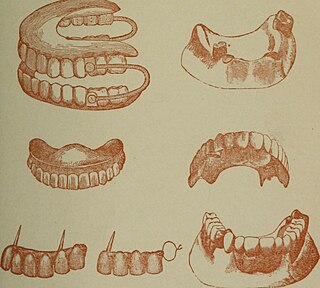
A denturist in the United States and Canada, clinical dental technologist in the United Kingdom and Ireland, dental prosthetist in Australia, or a clinical dental technician in New Zealand is a member of the oral health care team and role as primary oral health care provider who provides an oral health examination, planning treatment, takes impressions of the surrounding oral tissues, constructs and delivers removable oral prosthesis treatment directly to the patient.

A-dec is a dental office furniture and equipment manufacturer based in Newberg, Oregon, United States. It is considered one of the largest dental equipment makers in the world, and as of 2002 is Newberg's largest employer with 832 employees. Founded in 1964, the company's annual revenue of $250 million comes from the sale of products such as dental chairs, stools, delivery systems, medical lighting, cabinetry, and other accessories.

Fire services in the United Kingdom use a variety of fire appliances, which perform a wide range of general and specialised roles and fit into several distinct categories. Contemporary fire appliances carry a multitude of equipment and firefighting media to deal with different types of emergencies ranging from fires, rescues, vehicle extrication, floods, salvage, casualty and trauma care.
Planmeca, established in 1971, is a Finnish manufacturer of high-tech dental equipment, such as 3D and 2D digital imaging devices, dental units, CAD/CAM solutions and software.

A firefighting apparatus or firefighting appliance describes any vehicle that has been customized for use during firefighting operations. These vehicles are highly customized depending on their needs and the duty they will be performing. These duties can include firefighting, technical rescue, and emergency medical services.
Occupational hazards in dentistry are occupational hazards that are specifically associated with a dental care environment. Members of the dental team, including dentists, hygienists, dental nurses and radiographers, must ensure local protocols are followed to minimize risk.
Dentaid The Dental Charity is a British dental charity. The organisation is based in Totton, and has been active since the mid-1990s.
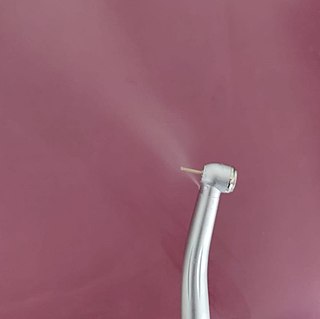
A dental aerosol is an aerosol that is produced from dental instrument, dental handpieces, three-way syringes, and other high-speed instruments. These aerosols may remain suspended in the clinical environment. Dental aerosols can pose risks to the clinician, staff, and other patients. The heavier particles contained within the aerosols are likely to remain suspended in the air for relatively short period and settle quickly onto surfaces, however, the lighter particles may remain suspended for longer periods and may travel some distance from the source. These smaller particles are capable of becoming deposited in the lungs when inhaled and provide a route of diseases transmission. Different dental instruments produce varying quantities of aerosol, and therefore are likely to pose differing risks of dispersing microbes from the mouth. Air turbine dental handpieces generally produce more aerosol, with electric micromotor handpieces producing less, although this depends on the configuration of water coolant used by the handpiece.
